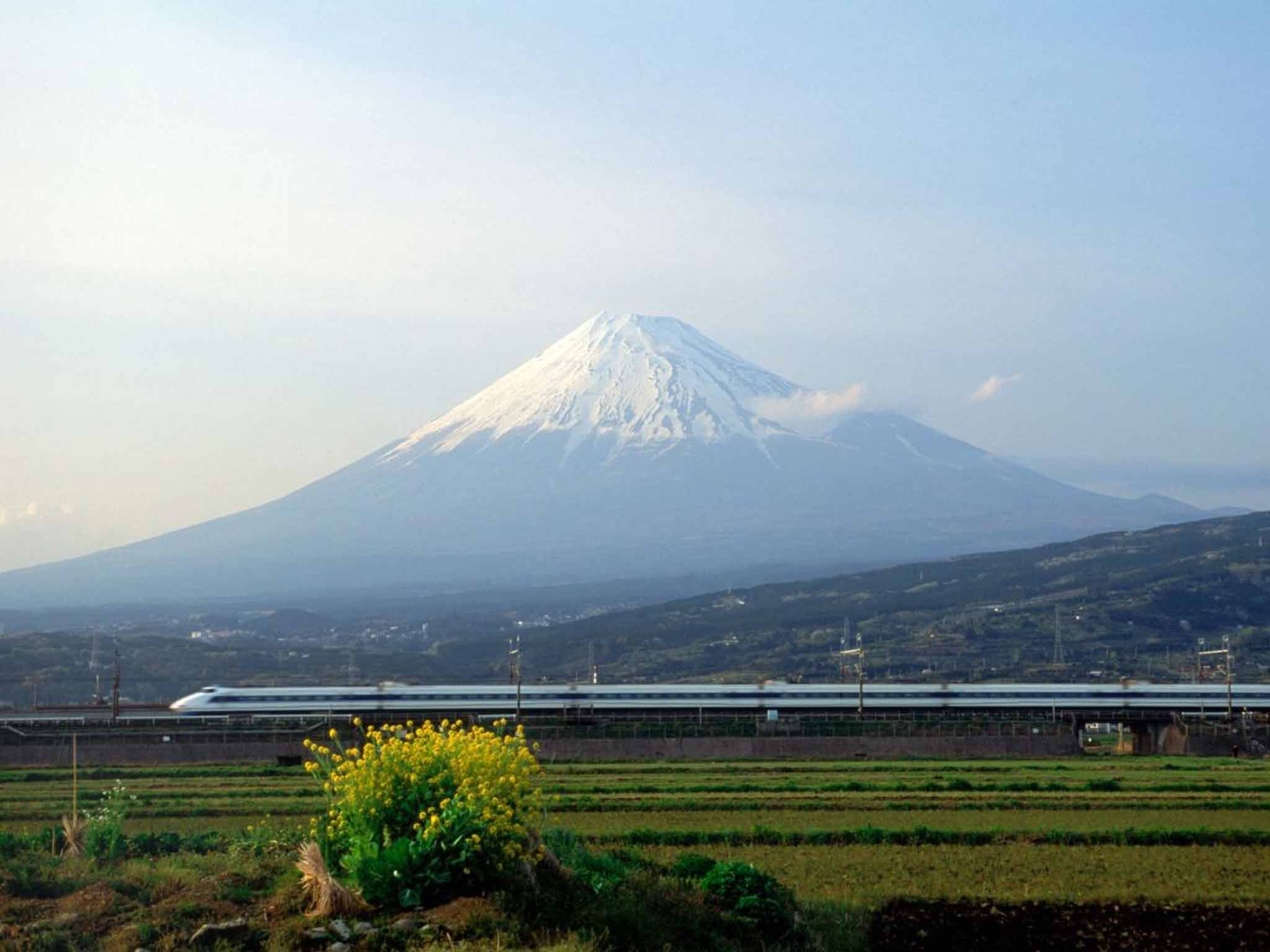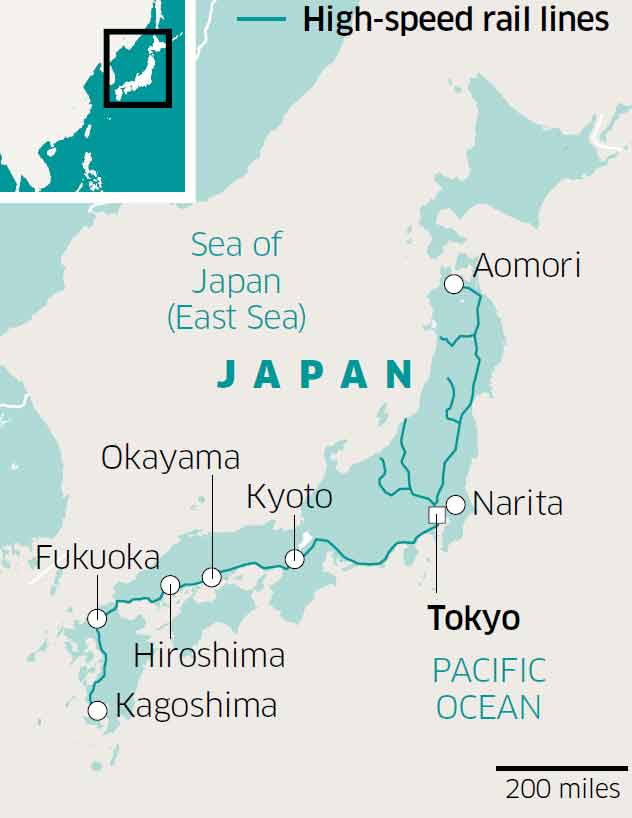Japan's 'bullet train': Fast track to the future
Stephen Bayley celebrates 50 years of the Shinkansen network with a journey from Tokyo to Fukuoka that's 'flawless, comfortable and punctual to the second'

Your support helps us to tell the story
From reproductive rights to climate change to Big Tech, The Independent is on the ground when the story is developing. Whether it's investigating the financials of Elon Musk's pro-Trump PAC or producing our latest documentary, 'The A Word', which shines a light on the American women fighting for reproductive rights, we know how important it is to parse out the facts from the messaging.
At such a critical moment in US history, we need reporters on the ground. Your donation allows us to keep sending journalists to speak to both sides of the story.
The Independent is trusted by Americans across the entire political spectrum. And unlike many other quality news outlets, we choose not to lock Americans out of our reporting and analysis with paywalls. We believe quality journalism should be available to everyone, paid for by those who can afford it.
Your support makes all the difference.If you want a sense of Japan, take the train. In 1964, while Britain was closing railway lines and stations, Japan was investing in sophisticated infrastructure. This year, 1 October marks the 50th anniversary of the Shinkansen, Japan's "bullet train". (Shinkansen actually means "New Main Line": to describe a ballistically fast train you must say "dangan ressha").
The New Main Line was uncompromising: tracks were isolated with no level crossings or other obstacles. Only suicides and earthquakes impair the Shinkansen's swift, silent function. The health of transport systems tells you a lot about the psychological realities of any nation, so I spent a week on the Shinkansen, thinking about Japan.
My first visit was in 1981. In those days the USSR did not allow over-flights so the old DC-8 lumbered over the North Pole and refuelled in Anchorage, Alaska, whose terminal's sole concession to curiosity was a stuffed polar bear in a glass case. We had driven to Heathrow in a period-piece Morris Minor which broke down in Hammersmith. This was so long ago that parking restrictions did not exist and we left it there for the duration of the trip.
I have been many times since, but Japan remains mostly baffling. With Zen-infused contrariness, three decades later, I found it both different and the same. Whatever is true, the opposite is truer: the Japanese have a great sense of beauty, but apparently no awareness of ugliness. Natural grace and high-frequency incidental rudeness co-exist. The language betrays a habit of mind that is quite alien: no definite or indefinite articles, no genders, no future tense. Tokyo lives with the paradox that the Great Kanto quake which destroyed the old "Low City" in 1923 led to the rebuilding which made modern Japan.
Even if your plan is to live on trains, only a few remote Shinkansen services have sleepers, so hotels are still needed. June is the rainy season. A plush Toyota Crown with grey brocade upholstery, lace antimacassars, and a driver in white gloves, rushed us from Narita through disobliging urban grimness, passing in the floods a car called Noah, to the sacramental calm of The Mandarin Oriental Hotel in Tokyo's historic Nihonbashi business district. It's a Cesar Pelli tower above the 1929 Mitsui Building (also designed by an American). Touchingly, the source of the Mitsui empire was a 17th-century kimono shop near this site.
The Shinkansen is proofed against earthquakes … so too are Japanese hotels, at least the recently built and ambitiously tall examples. On board the train, a system called UrEDAS (Urgent Earthquake Detection and Alarm System) automatically brakes the trains in the event of a major shudder. In the Mandarin Oriental, a semi-active mass-damper system absorbs shocks, although you are warned that the windows might pop out. "Should your staircase fill with debris ..." goes one instruction in the in-room disaster briefing document.
Sensing my unease 30 floors up, the mind-reading service of this outstanding hotel ensured that opaque blinds were always drawn in our room. And a favourite beer, Suntory Premium Malt, made available as a tranquiliser. Additionally, this is a hotel with a fake French cave on the 37th floor, accessed by a precipitous spiral staircase. And a loo on the 38th where gentlemen may stand at a urinal abutting a floor-to-ceiling window and wave at admirers below.
Our supermarket deli-counters and iffy chains have suburbanised Japanese food with the result that it seems very familiar, but, with that familiar Zen refraction, when you get here it is also very different. Specific recommendations are pretty useless in Japan, as cab-drivers can never find anywhere (Tokyo was only given its few street names by the Americans after 1945). But Sushi Sora in the Mandarin Oriental has a sake sommelier and a strong whiff of high-end cosmopolitan competence: as a cucumber is peeled with the attention of a ritual dismebowelling, you learn that "suzuki" means a mature sea bass. You are taught levels of connoisseurship in soy sauce. This is one of the hotel's 10 restaurants. Rene Redzepi arrives next year.
Otherwise, to eat well, you need a good nose and good luck. Walk around Tokyo's Vuittonised Ginza – where God is in the retail – but turn off the main drag to find an exquisite curio such as Hiragawa, an amalgam of florist and craft shop serving dishes of tempura with ferns and links of caperberries against a background of tinkly jazz.
Off Cat Street in smart Omotesando, we found a cosmetic shop with a fine restaurant called Revive attached. In the side streets of Nihonbashi, you may be lucky to find Dabo Haze, a 10-seater where the same chef has been deep-frying twitching prawns for 55 years. We sat next to a man who made automatic de-burring machines for Rolls-Royce.
Our travel plan was two days in Tokyo, reconsidering the epic strangeness of an enormous city with no centre, where cab drivers dress like admirals. Then to Kyoto, the historic capital. Next, an island called Naoshima in the mysterious Inland Sea then on to gritty Fukuoka, nearer to Seoul than Tokyo, a city that, without irony, styles itself the "Liverpool of Japan".
There are no restaurant cars on the Shinkansen, so the prudent make their own arrangements. This is easily done at Tokyo Station because next door is a coruscating Daimaru department store whose basement is a sketch for a 22nd-century Waitrose and where you pick-up a bento box and some cold beer.
On the platform (although the Japanese insist on the American "track") you watch the dazzlingly white and serpentine Shinkansen make its slithering progress to a very short stop. No longer a "bullet", the latest version has a prognathous snout which suggests, to my eye at least, a fierce hi-tech samurai. The serene journey to Kyoto takes precisely 164 minutes.
Kyoto is punk and imperial; you find, or I did, ghosts of Rashomon, Akutagawa's classic tale of the half-dead and grave-robbers. The city is still laid-out on a grid from the Edo era, but, incongruously, you also find electrical plant on the streets. They have not yet got around to putting high-tension cables underground.
Yet nothing detracts from the aura of this sacred place. Steve Jobs visited Kyoto often and found inspiration for Apple in the Saihoji Moss Temple. I also suspect he shopped at Kaikoda, a workshop making precision metal tea canisters since 1875: the aesthetic is explicitly iPhone.
But to remind you that we are in modern Japan, the new Ritz-Carlton has Louis Jadot white Burgundy in the minibar and a Pierre Hermé concession in the lobby. This is shut at the weekend so girls in geisha costume serve chizou, a welcome tea. It is difficult for traditional Japanese architecture to look anything other than institutional, but this is beautiful. A bedroom over the Kamogawa river frames a view an artist of The Floating World would have recognised: sleepless, I watched a red disk of sun rise behind hills robed in mist with trees in silhouette. Ducks quacked.
The island of Naoshima is so remote that it is beyond the reach of the Shinkansen. The New Main Line gets you to featureless Okayama, then you need two JR Line trains, immaculate, but slow, to a little port called Uno. Then a ferry, immaculate but slow, takes you to Miyanoura where the journey continues to Benesse House …. A flyer was handed out at the docks instructing us that the architect Tadao Ando was coming that day.
He has been before: the village of Honmura is an "artsite". Vernacular houses have been made over – with uneven effects – by artists, while Ando has designed an installation for James Turrell, a public lavatory, the Chi Chu Museum and Benesse House itself, another art gallery with guest rooms. The former has the most perfect picture-hanging I have ever seen: a vast Monet in diffused natural light. The latter is an experience strange enough for a psychological thriller: the ferry stops, the lights go down and you spend the night in a Minamalist cell with Warhol and Hockney for neighbours. Through the window, a greyscale of sea and sky exactly like one of the Sugimoto photographs decorating the restaurant's open space.
So what of the Shinkansen? Few things focus a mind soothed by cold beer and rice crackers more quickly than an on-board moving message saying "we will soon be making a brief stop in Hiroshima", a city where time itself once stopped.
Shinkansen is an idea dating from the 1930s intending to link the fast emerging Japan to the mainland. That never happened, but it radicalised business and social life at home. It is flawless, comfortable, and punctual to the second. (Although travellers should note that there are three service types: Nozomi stops nowhere, Hikari stops somewhere, and Kodama stops everywhere.)
Even in a culture that fetishises cleanliness and order, Standard Class has snoring slobs. Make sure your reservation is for The Green Car (a non-divisive way of saying "First Class"). Girls with rubbish bags pass through every few minutes bowing to the cabin. Everyone bows to everyone on every passage.

It is six hours from Fukuoka to Tokyo so you get time to think. What I think is: nations need their symbols. We got Concorde ... Japan got this perfect white object which mockingly slides, air-conditioned and apparently frictionless, through the interminable grey industrial subtopia that produced it. But like Concorde, there's a paradox: it is so comfortable and impressive you don't want to get off. The last words of Rashomon? "Beyond this only darkness ... unknowing and unknown".
Travel essentials
Stephen Bayley flew with Virgin Atlantic (0344 209 2770; virgin-atlantic.com) which departs daily to Tokyo Narita from Heathrow. Return fares start at £841.
Getting around
He was a guest of Abercrombie and Kent (0845 485 1142; abercrombiekent.co.uk), which offers a 13-day trip in Japan from £3,250pp, including international flights, accommodation and travel on the Shinkansen.
More information
Japan National Tourism Organisation: seejapan.co.uk
Join our commenting forum
Join thought-provoking conversations, follow other Independent readers and see their replies
Comments